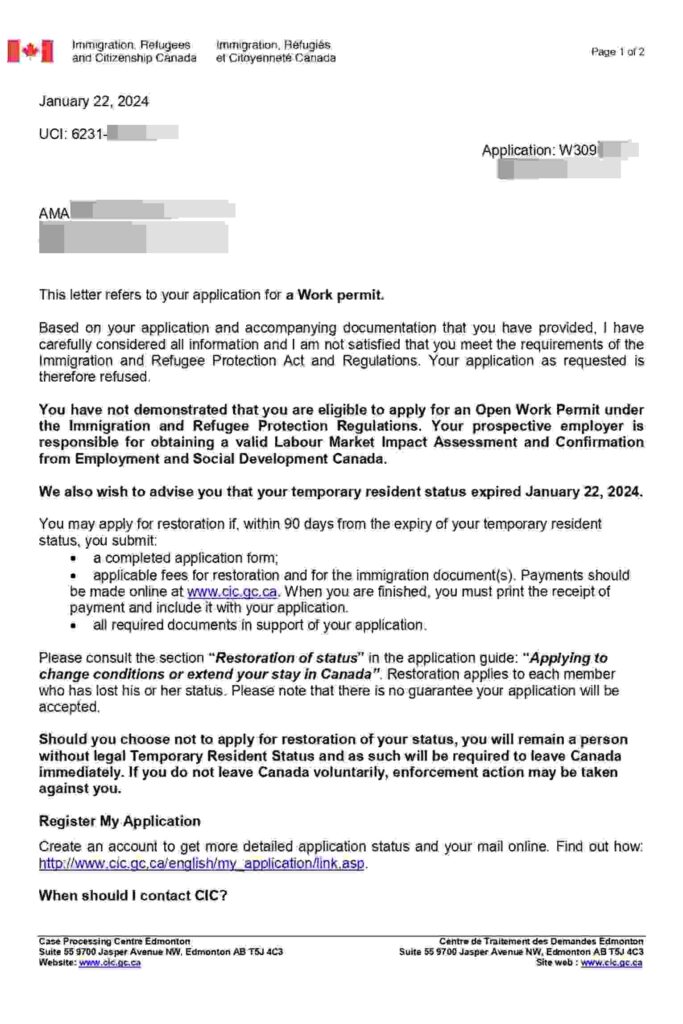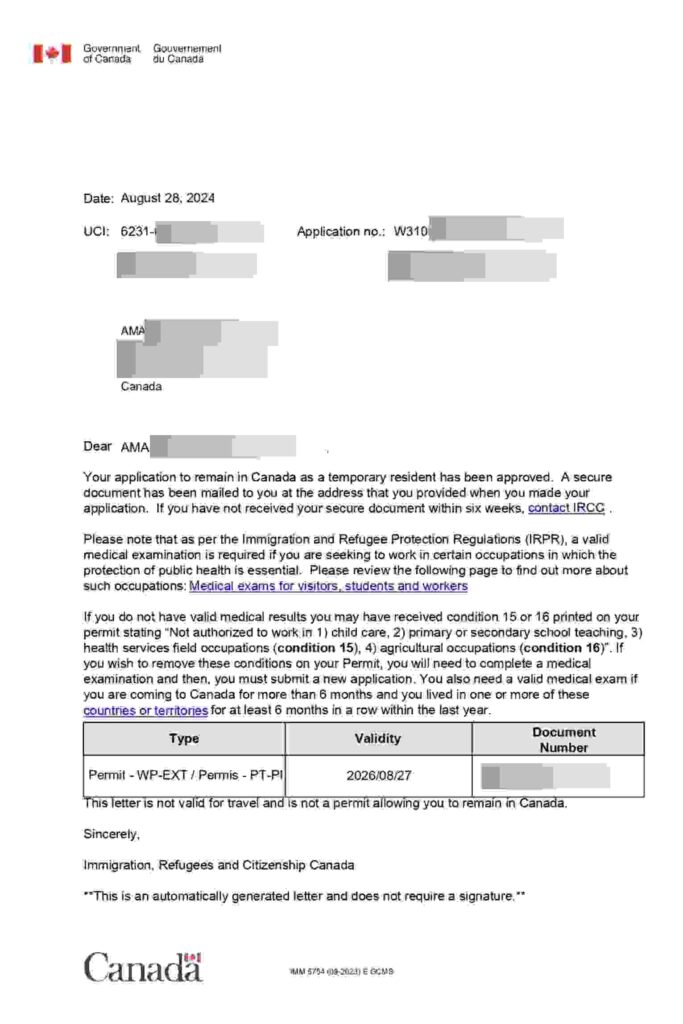Case Study: Restoration of Status Canada
At Arnika Visa, we frequently encounter clients who, despite their best efforts, find themselves in difficult situations due to unintentional errors in their immigration applications. This case involves a worker in Canada who mistakenly applied for the wrong type of work permit, leading to a refusal and requiring swift action for restoration Status Canada. It’s another example of how navigating Canadian immigration regulations can be complex and how Arnika Visa can provide guidance to resolve such issues effectively.
Background of the Case
Our client, a skilled worker in Canada, had been working under a valid work permit, which was set to expire on October 28, 2023. As the expiration date approached, they took responsible steps to maintain their status. On October 10, 2023, he received an Invitation to Apply (ITA) for permanent residence under the Canadian Experience Class (CEC) through the Express Entry system—a significant achievement on their journey toward becoming permanent residents of Canada.
They submitted their permanent residence application on December 4, 2023, and to ensure their ability to continue working in Canada while awaiting the outcome, they applied for a work permit extension on October 28, 2023. However, an unfortunate mistake was made instead of applying for a Bridging Open Work Permit (BOWP), which is specifically designed for individuals in the process of applying for permanent residence, the client mistakenly applied for an Open Work Permit (OWP), which typically requires a Labour Market Impact Assessment (LMIA) from the employer.
The Consequences of a Mistaken Work Permit Application
On January 22, 2024, the client received a Canada work permit refusal letter from Immigration, Refugees, and Citizenship Canada (IRCC). The refusal letter stated that the client’s application for an Open Work Permit could not be processed without a valid LMIA from their prospective employer. Since the client was eligible for a Bridging Open Work Permit instead, this refusal directly resulted from applying for the wrong type of work permit.
Upon receiving the Canada work permit refusal letter, the client realized the mistake—they had misunderstood the work permit options available to them while awaiting their permanent residency. This error left them without valid status in Canada, and they now had 90 days to apply for restoration of status as workers or face the possibility of having to leave the country.
Canada work permit refusal letter

Seeking Professional Help: Restoration of Status Application
At this crucial juncture, the client contacted Arnika Visa for assistance. Understanding the urgency, our team quickly took over the case and reviewed the refusal and the client’s immigration status. Since the client’s work permit had already been expired, we immediately initiated the restoration process.
The first step was to submit a restoration of status application as a worker, which is required within 90 days of losing legal status. Without this application, the client would have had to leave Canada and potentially face further complications when trying to re-enter.
Our regulated Canadian immigration consultant, RCIC (Reza Eslami) meticulously prepared the restoration application, which included a detailed explanation of the mistake made in the previous work permit application. He emphasized that the error was an honest misunderstanding and that the client had applied in good faith, unaware that they should have applied for a Bridging Open Work Permit instead of an Open Work Permit. The client’s intention was always to comply with immigration regulations, and this application was part of their effort to rectify the situation.
Submitting the Correct Work Permit Application
While the restoration application was being processed, Arnika Visa also guided the client through submitting the correct application for a Bridging Open Work Permit (BOWP). This type of permit allows individuals who have applied for permanent residence through Express Entry to continue working in Canada while their application is being processed. Unlike an Open Work Permit, a Bridging Open Work Permit does not require an LMIA and is specifically tailored to individuals awaiting a decision on their permanent residence application.
By submitting both the restoration application and the correct Bridging Open Work Permit application, we ensured the client could remain in Canada while awaiting decisions on both fronts.
Approval and Restoration of Status
After thorough preparation and timely submission, we are happy to report that on August 27, 2024, the client’s work permit was approved. The approval of the Bridging Open Work Permit meant that the client could continue to legally work in Canada while awaiting their permanent residence decision.
In addition to the work permit approval, the client’s status as a temporary resident was successfully restored. This not only relieved the client of the stress and uncertainty they had been facing but also allowed them to continue their life in Canada without any further disruptions to their employment or future immigration prospects.
Canada work permit approval letter

Lessons Learned: Avoiding Unnecessary Pitfalls
This case demonstrates how easily mistakes can occur when navigating the complexities of Canadian immigration regulations. Had the client sought professional help from the outset, the confusion surrounding the work permit types could have been avoided, and they could have maintained their status without the need for a restoration application.
At Arnika Visa, we always encourage individuals to consult with experienced immigration professionals when preparing important applications like work permits. Small errors can lead to significant consequences, such as status loss, refusals, and financial strain. However, with the right guidance, these situations can be managed effectively.
Conclusion: A Positive Outcome
Ultimately, the client’s status was restored, and their Bridging Open Work Permit was approved. This allowed them to remain in Canada, continue working, and wait for the final decision on their permanent residency application with peace of mind. The timely intervention of Arnika Visa was key to resolving this case and ensuring that the client’s immigration journey stayed on track.
The client is now back to work and contributing to the Canadian workforce, knowing that their future in Canada is secure while they await permanent residency. This success story is a testament to the value of professional immigration guidance and the importance of understanding the nuances of Canada’s immigration pathways.
At Arnika Visa, we take pride in helping clients navigate these complexities and achieve successful outcomes. If you or someone you know is facing similar immigration challenges, such as work permit refusals, restoration of status, or issues related to out of status in Canada applications, our experienced team is here to assist. We are dedicated to ensuring that your immigration process is smooth, efficient, and successful, just as it was for this client.
Reach out to us today for professional support in your immigration journey, and let us help you achieve your goals in Canada.
How to apply for restoration of status in Canada?
To apply for restoration of status Canada, submit an online application within 90 days of losing your status. Log in to your IRCC secure account, complete the relevant form (e.g., IMM 5708 or IMM 5710), upload the required documents, write an explanation letter for the lapse, pay the restoration fee, meet the conditions of your original status, and submit the application within 90 days of losing your status. Restoration isn’t guaranteed and is assessed case-by-case.
For restoration of status after 90 days, restoration is no longer an option. You may need to leave Canada and reapply for status from outside the country or, in some cases, apply for a Temporary Resident Permit (TRP) if justified by compelling reasons to remain in Canada despite their inadmissibility or out-of-status issues. , The application for spouse sponsorship in Canada for individuals who are out of status in Canada but have a Canadian spouse or common-law partner, or for individuals who are out of status in Canada and an H&C application (Humanitarian and Compassionate Ground Canada) for have compelling reasons for remaining in Canada based on humanitarian and compassionate grounds.



